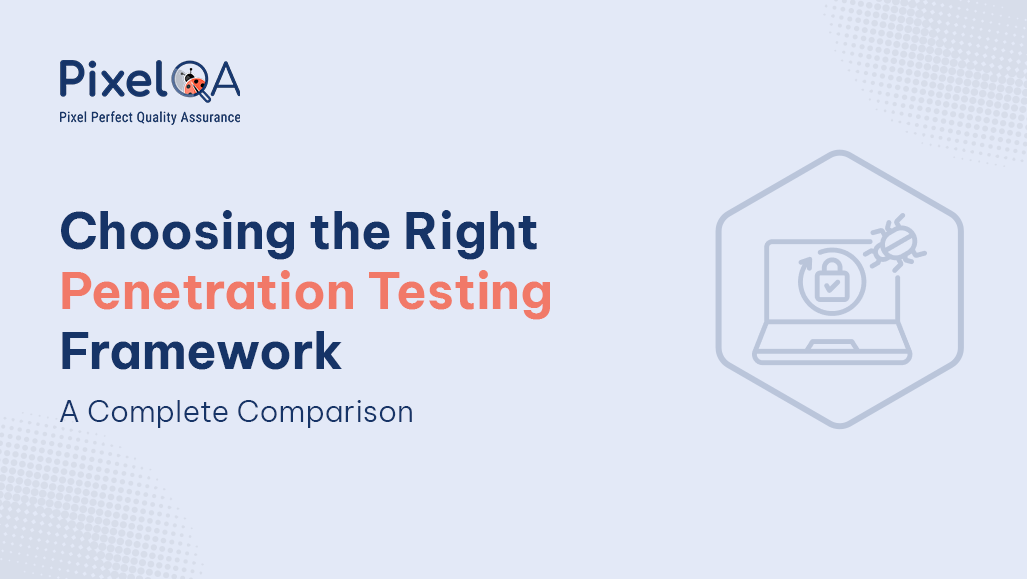
Introduction
Penetration testing is an essential method in cybersecurity that finds system flaws that bad characters on screen can take advantage of. With the development and return of cyber threats to organizations, the significance of advanced security measures becomes inevitable. This is where penetration testing services come in really handy. The use of Penetration testing frameworks, all-inclusive tools that provide structured methods for security professionals, has increased because of this recognition. Instead of guiding analysts through every aspect of the testing process, these technologies ensure thorough evaluations and trustworthy results. To help you choose the best penetration testing system for your company, we will analyze several popular systems in this online article, taking into consideration several factors including the center region.
Table of Contents
- What is a Penetration Testing Framework?
- Overview of Popular Penetration Testing Framework
- Comparing the Frameworks
- Choosing the Right Framework for Your Needs
- Conclusion
What is a Penetration Testing Framework?
Essentially, a penetration testing system is a triad of a rule, best practice, and technique phenomena relevant to security experts conducting penetration testing successfully. These systems standardize the method of testing in order to penetrate a system, find errors, and conduct complete risk assessment.
- Standardization: Systems increase testing efficiency and consistency by providing an organized approach, enabling teams to complete a thorough overview of potential security flaws. In larger businesses, where multiple groups may conduct tests at the same time, this is especially crucial.
- Phases of Testing: Systems increase testing proficiency and consistency by providing an organized approach, enabling teams to complete a thorough move of potential security flaws. This is especially important in bigger companies because multiple groups may be conducting tests independently.
- Documentation and Reporting: Strong systems place a high priority on the value of documentation, which not only makes things easier but also promotes further testing by providing accurate information.
- Adaptability: Using a system can basically simplify your efforts, making it easier to adapt to unique conditions or advancements, regardless of whether you are an experienced analyzer or new to penetration testing.
Overview of Popular Penetration Testing Framework
1. OWASP Testing Guide
Web application security is the focus of the OWASP Testing. It provides a thorough and well-structured method, outlining specific tactics and tools for testing websecurity testing.
Key Features:
- Checklist Approach: Provides detailed checklists for the various testing phases.
- Security Risks: Highlights typical vulnerabilities such as SQL injection and cross-site scripting (XSS).
- Use Cases: Particularly important for companies that value web penetration testing services, particularly those that handle private client information.
2. NIST SP 800-115
The National Institution of Standards and Technology (NIST) regulations include the NIST SP 800-115. It stresses risk management and compliance and provides thorough guidance for various frameworks.
Key Features:
- Framework Structure: Provides a flexible framework that may be modified to meet various organizational requirements.
- Compliance Focus: Complies with government regulations and is suitable for businesses that have specific administrative requirements.
- Broad Applicability: Ideal for businesses that must conduct systematic, risk-based security testing.
3. PTES (Penetration Testing Execution Standard)
From pre-engagement to testing and announcement, PTES is a comprehensive, community-driven system that handles all aspects of entry testing.
Key Features:
- Phased Approach: Ensures thorough execution by clearly outlining the steps of a penetration test.
- Community Support: Supported by a vibrant community that provides sufficient information and documentation.
- Ideal for Teams: An amazing option for organizations seeking a comprehensive penetration testing strategy.
4. CREST (The Council of Registered Ethical Security Testers)
In order to improve the caliber of penetration testing administrations, Peak focuses on expert certification and best practices.
Key Features:
- Certification Process: Provides specialists with credentials, ensuring a high level of benefit.
- Best Practices: Sets standards for penetration testing's morality and quality.
- Target Audience: Organizations that value authorized testing and demand a high level of benefit are the best candidates.
Comparing the Frameworks
Comparing several entrance testing systems is essential when selecting one to determine which best suits the requirements of your company.
Focus Area
Some frameworks are tailored for specific environments. For instance:
- OWASP Testing Guide is particularly suited for web Security testing.
- NIST SP 800-115 can be applied to a broader range of systems, including networks and cloud infrastructures.
Methodology
Frameworks may offer structured methodologies or allow for more flexibility.
- A structured approach (like NIST) can provide consistency across tests.
- A flexible methodology (like PTES) may enable more tailored testing based on specific client needs.
User Base
Consider the target users of each framework.
- Some frameworks are more beginner-friendly, providing clear guidance and checklists.
- Others may cater to experienced testers seeking advanced techniques and insights.
Community and Support
The availability of resources, forums, and documentation can vary significantly.
- A strong community can provide valuable support, tutorials, and updates, which can enhance the learning experience.
Cost and Accessibility
Some frameworks are available for free, while others may involve costs, particularly those that offer certifications or formal training programs.
- Evaluate the cost versus the potential value each framework brings to your organization.
Choosing the Right Framework for Your Needs
Make sure you inspect your business's particular needs before selecting your penetration testing system.
Key Considerations:
- Assess Your Environment: You should note and reflect upon the variety of frameworks you will be testing-including cloud environments, API's or online apps, or complete systems.
- Regulatory Requirements: Consider any legal obligations your business might face, such as GDPR or HIPAA.
- Evaluate Your Team’s Skill Level: If someone wants to get the most benefit out of any solution, that solution should be compatible with the staff within the setup. If the frame is new to penetration testing, it might be better to work within more guided frameworks.
- Long-Term Security Goals: It's important to choose a framework for your company that fits the overall security strategy and will support future growth.
- Pilot Testing: Consider piloting frameworks to see which one best suits your organization's needs and testing culture. This way, you would gain good practical experience on usability and effectiveness.
Conclusion
Choosing the right penetration testing tool is important in hardening the cybersecurity defenses of your organization. Most appropriate will depend on specific needs, goals, and resources. You may make a better-informed decision that supports your security efforts and helps protect your frameworks from potential threats by investing time in understanding and assessing unique systems.
About Author

Rushi Mistry is a Security Tester at PixelQA a Software Testing Company with a focus on cybersecurity. He is passionate about IoT penetration testing and is working towards obtaining a CISSP certification, with the ultimate goal of becoming a Chief Information Security Officer (CISO).




